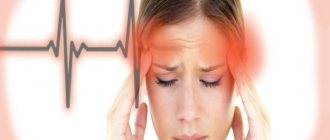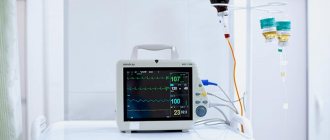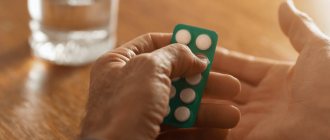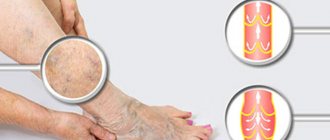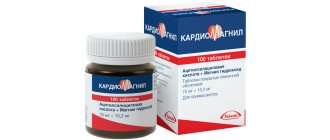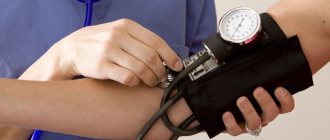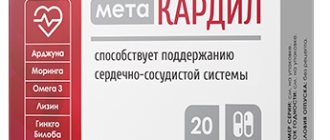Aspirin is a popular drug in the category of non-steroidal anti-inflammatory drugs. It is also used for the prevention of diseases of the cardiovascular system. There is one persistent myth that aspirin thins the blood and is indicated for the prevention of cardiovascular diseases. However, this is not entirely true. Aspirin affects blood clotting and, as a result, the process of thrombus formation. But the thickness of the blood is affected by the amount of hemoglobin and red blood cells. The lower their value, the more liquid the blood in the body.
In this article we will consider in detail the drug aspirin cardio. How does it differ from the usual simple aspirin, what effect does it have on the body and cardiac activity in particular.
Medicine aspirin cardio
In addition to the fact that the drug belongs to the category of NSAIDs and has an antipyretic effect and analgesic effect, aspirin cardio is used in the primary prevention of diseases of the cardiovascular system and in the secondary prevention of myocardial infarction. Reduces the risk of developing the disease with unstable angina. The drug is prescribed for cardiovascular pathologies due to its antithrombotic effect.
The main difference between the drug and regular aspirin is that aspirin cardio is coated with a special enteric coating. Due to this, it is used for long courses in cardiology. This coating allows the active substance to be released in the intestines, thereby minimizing one of the main side effects of aspirin - damage to the gastric mucosa.
Composition of the drug
The active ingredient of the drug is acetylsalicylic acid.
Excipients include corn starch and cellulose powder.
The enteric coating contains polysorbate, sodium lauryl sulfate, talc and other compounds.
Thus, when prescribing the drug, individual intolerance to the components of the composition should be taken into account.
Release form and dosage
The drug aspirin cardio is available only in the form of enteric-coated tablets in dosages of 100 mg and 300 mg.
The number of tablets in a package can be: 20 pcs., 28 pcs., 56 pcs.
Adverse reactions and overdose
While taking the medicine, undesirable reactions may occur:
- increased susceptibility to the constituent components, manifested by skin rash;
- pain in the abdomen.
With regular and frequent use, in rare cases, bleeding from the stomach may begin, which is manifested by the following symptoms:
- anemia;
- malaise;
- unbearable pain in the stomach.
If such signs appear, you should immediately stop taking it and inform a specialist.
An overdose of the drug is manifested by the following symptoms: nausea, vomiting, hearing problems, confused thinking.
Indications for aspirin cardio
- Primary prevention of acute myocardial infarction, taking into account aggravating risks - hypertension, diabetes mellitus, obesity, smoking.
- Prevention after a heart attack.
- Stable and unstable angina (including suspicion of acute myocardial infarction).
- Prevention of stroke (including in patients with transient cerebrovascular accident).
- Prevention of cerebrovascular accidents.
- Prevention of thromboembolism after operations on blood vessels and arteries (bypass surgery, endarterectomy, angioplasty and stenting).
- Prevention of deep vein thrombosis and thromboembolism of the pulmonary artery and its branches (including long-term immobilization as a result of extensive surgery).
Methods of application
The method of administration and dosage regimen of the drug depend on its release form and other factors. The optimal dosage regimen is determined by a specialist based on specific indications. It is advisable to take aspirin cardio tablets orally before meals with plenty of liquid, preferably at the same time, once a day.
The duration of therapy is determined by the doctor. The usually recommended dose is 100 mg 1 time per day, but the approach to the dosage regimen is individual. Depending on the indications, it may increase to 300 mg/day.
Primary prevention of acute myocardial infarction in the presence of risk factors: 100 mg/day or 300 mg every other day.
- The recommended dosage for the prevention of recurrent infarction is 100-300 mg/day.
- For unstable angina, as well as the onset of myocardial infarction, the initial dose is 100-300 mg. In this case, the first tablet is chewed to speed up absorption. The drug should be taken as soon as possible at the slightest suspicion of danger. For a month after the attack, a maintenance dose of 200-300 mg/day is recommended. Further, all treatment recommendations are prescribed by a specialist based on the patient’s vital signs.
- Prevention of stroke and cerebrovascular accident: 100-300 mg/day.
- Prevention of thromboembolism after vascular surgery: 100-300 mg/day.
- Prevention of deep vein thrombosis and pulmonary embolism: 100-200 mg/day or 300 mg every other day.
The compliance of the dosage form of a particular drug with the indications for use and dosage regimen should be strictly observed.
How do you know that the benefits outweigh the harm?
The doctor, with your help, will collect and analyze many factors and then make a decision. You yourself can try to assess your risks using an online calculator developed by American cardiologists.
Remember that arterial hypertension itself is not an indication for prescribing aspirin if the patient does not have a diagnosis of coronary heart or brain disease! On the contrary, poorly controlled, high blood pressure is often a contraindication to the use of aspirin, since sudden increases in blood pressure increase the risk of intracerebral bleeding, and aspirin can significantly increase it.
In addition, aspirin may reduce the effectiveness of some drugs used to treat hypertension, such as enalapril, captopril, lisinopril, perindopril, and beta blockers.
If taking preventative aspirin turns out to be unreasonably dangerous for you, your doctor will suggest other prevention options, such as lifestyle changes or taking statins.
Currently commercially available are predominantly low-dose enteric-coated aspirin tablets. The outer shell “dissolves” only in the small intestine, protecting the stomach from irritation. These tablets must be swallowed whole without chewing.
There are also combination preparations containing the additive magnesium hydroxide. It is believed that magnesium in this combination reduces the harmful effects of acetylsalicylic acid on the mucous membrane of the stomach and intestines.
And don't use aspirin if the tablets smell strongly of vinegar—the medicine has probably gone bad!
In order for aspirin to effectively protect your blood vessels, it is prescribed for daily long-term, usually lifelong use. Most likely, you will not feel any changes in your body after starting treatment - but this does not mean that aspirin does not work!
Contraindications
Express contraindications include:
- allergy to the active substance and components of the drug,
- Gastrointestinal diseases, including erosions, ulcers in the acute stage,
- diseases of the bronchopulmonary system
- hemorrhagic diathesis,
- pregnancy and lactation (the 1st and 3rd trimesters are considered especially dangerous)
- aortic aneurysm
- renal or liver failure
- and children under 15 years of age.
In a shell or without?
Coated aspirin tablets are designed to pass through the stomach without disintegrating until they reach the intestines. The protective coating is thought to allow aspirin tablets to be gentler on the stomach lining, and may be useful for people with a history of gastritis or ulcers who take aspirin daily.
However, some researchers believe there is no evidence that coated aspirin reduces the risk of gastrointestinal bleeding. Moreover, there are a number of publications that such aspirin is less effective for preventing heart attacks.
Special Recommendations
Aspirin cardio and chronic diseases
Particular caution should be exercised when taking aspirin for persons suffering from diseases of the respiratory system. The fact is that taking aspirin causes a narrowing of the bronchi, which can cause so-called aspirin asthma, or provoke asthma, which is in remission.
Aspirin cardio and childhood
When taken in its pure form in children, due to their young age, the concentration of glucose in the plasma can sharply decrease, in parallel with this, the level of ketone bodies in the blood increases, plasma acidification occurs, and fatty acids accumulate in the liver. These metabolic disturbances lead to swelling of tissues and organs.
Children become more than just lethargic. Aggravating symptoms such as cramps, diarrhea, rapid breathing and palpitations may occur. Up to loss of consciousness and severe muscle hypotension. Such conditions in children can be life-threatening, so the drug is contraindicated for them.
Aspirin cardio and alcohol
The combined use of alcohol and aspirin is not recommended. Alcohol and alcohol-containing products are known for their vasodilating properties. But in combination with aspirin, the effect can be most unexpected. The risks of bleeding increase, including in diseases of the gastrointestinal tract, exacerbation of liver diseases or the occurrence of any acute symptoms associated with this organ.
Aspirin cardio and pregnancy
The active substance freely and easily penetrates the placental barrier, which can lead to negative consequences for the fetus.
When used in the first trimester, it leads to the development of a “cleft palate” (cleft palate); in the third trimester, it causes inhibition of labor, premature closure of the ductus arteriosus in the fetus, disruption of the functioning of the pulmonary vessels and hypertension in the pulmonary circulation.
Acetylsalicylic acid is also excreted in breast milk, which increases the risk of bleeding in the baby due to impaired platelet function. Therefore, the advisability of using the drug during pregnancy and lactation should be justified by the specialist making the decision on the prescription.
Drug interactions with daily aspirin therapy
The combination of taking aspirin with anticoagulants can significantly increase the risk of serious hemorrhagic complications. Such concomitant therapy should be carefully discussed with your doctor.
Some medications may also increase the risk of bleeding. Medicines that may interact with aspirin include:
- Heparin
- Ibuprofen (if taken regularly)
- Corticosteroids
- Clopidogrel
- Some antidepressants (clomipramine, paroxetine, etc.)
Taking certain dietary supplements may also increase the risk of bleeding. These include:
- Blueberry
- Capsaicin
- Cat claw
- Evening primrose oil
- Ginkgo
- Omega-3 fatty acids (fish oil)
Heart pills prescribed for older people
With age, the body reacts differently to medications, and if previously some tablets helped, then during exacerbation of chronic diseases they may be contraindicated for use. In any case, it is better to consult a doctor and undergo the necessary examination, do an electrocardiogram.
The cardiologist will make an accurate diagnosis and prescribe treatment in accordance with the characteristics of the body and the presence of individual indications. Along with heart medications, medications can be prescribed to prevent atherosclerosis, antithrombosis and strengthen the walls of blood vessels, lowering blood pressure.
For older people, different heart pills may be recommended:
- Adonis-Bromine, Celanide, Digoxin, containing cardiac glycosides with a pronounced cardiotonic effect, for stimulation of the myocardium and correction of arrhythmia.
- Nitroglycerin or Nitrocor, Monosan, Cardiket are used to relieve attacks of angina pectoris and are classified as vasodilators.
- Concor, Biprol, Atenol, Betacard, Korgard and other β-blockers for the prevention of heart attack, with high blood pressure and severe heart contractions.
- Corinfar, Cordaflex, Verapamil or Lekoptin, Veracard and other calcium channel blockers dilate arteries, relax the walls of blood vessels, and act against arterial hypertension.
- Cocarboxylase, ATP, Vitrum Cardio Omega-3, metabolic drugs to improve metabolism.
Many other cardiotonic drugs from the groups included in the Classification of Cardiological Drugs are also prescribed, according to clinical recommendations adopted by the Russian Society of Cardiology. The use of advanced experience and developments of scientists, research and educational institutions in this field of medicine allows us to successfully implement the most effective methods for treating diseases.
Natural alternative
Anti-inflammatory diet
If you are using aspirin to relieve swelling or inflammation, keep in mind that this can be achieved in other, more natural and safer ways. The best place to start is with your diet.
First of all, you need to avoid foods that cause inflammation, swelling and pain: fast food, processed and packaged foods, foods containing artificial ingredients and added sugar, high amounts of caffeine and alcohol.
Instead, focus on eating healthy to help manage inflammation. Anti-inflammatory foods include:
- leafy greens and colored vegetables
- fruits such as blueberries and pineapple
- healthy fats, such as wild salmon and coconut oil
- bone broth
- nuts and seeds, such as walnuts, flax and chia seeds
- high quality free range meat and organic chicken
- anti-inflammatory spices such as ginger, cayenne pepper and turmeric
Ginger
Did you know that ginger has antithrombosis properties? Regular consumption of ginger can actually prevent the occurrence of heart attack and stroke.
In addition, ginger can relieve pain and cope with inflammation. Gingerol, the most powerful healing substance in ginger, affects receptors that are located on our nerve endings.
Research suggests that due to its ability to fight pain and inflammation, ginger is often used as part of natural therapy to treat degenerative diseases such as arthritis and rheumatism, as well as cardiovascular disorders such as hypertension and atherosclerosis.
Turmeric
Research shows that turmeric may even be more effective than some anti-inflammatory drugs, anticoagulants and painkillers. Moreover, turmeric does not have any side effects unless consumed in too much quantity.
Research also suggests that curcumin in turmeric has antithrombotic effects, and daily consumption of this spice may help thin the blood.
Scientists believe that turmeric extract can be used as a pain reliever. A meta-analysis published in the Journal of Medicinal Food found that 1,000 mg of curcumin per day was effective in relieving pain in patients with arthritis.
In fact, five studies found no significant difference between the effectiveness of turmeric and painkillers.
Cinnamon
Cinnamon may not only fight inflammation, but also promote heart health. Research suggests that the main benefit of cinnamon is its ability to reduce the risk of heart disease by lowering blood pressure and cholesterol levels.
Scientists have found that cinnamon acts as a natural coagulant and can speed up blood flow. The spice promotes tissue repair and cell regeneration, which can help your body cope with a heart attack or stroke.
Methylsulfonylmethane
Methylsulfonylmethane (MSM) is a plant-derived adaptogen that helps manage stress and recover from injury, surgery, and exercise. MSM supplements are often used to relieve chronic pain, muscle cramps, lower blood pressure, and relieve eye inflammation.
MSM fights inflammation thanks to the sulfur it delivers to your body. Sulfur helps restore muscle cells. Research has shown that MSM also helps restore flexibility and permeability of cell walls within muscles, which speeds up muscle recovery.
Bromelain
This enzyme is present in pineapples and is often used to treat inflammation caused by diseases such as arthritis. Research suggests it may be used to relieve post-surgical pain and swelling, joint pain and sinus inflammation.
A study published in the journal Biomedical Reports found that bromelain has anti-inflammatory and antithrombotic effects. It effectively speeds up blood flow and strengthens the immune system.
Magnesium
Scientists have found that magnesium deficiency can lead to a range of problems, including hypertension, cardiovascular disease, kidney and liver damage, muscle spasms, decreased immunity and migraines.
Supplementing with magnesium will keep your blood pressure normal and prevent hypertension. A study from the Journal of Clinical Hypertension found that heart diseases such as coronary artery disease, ischemic stroke and heart rhythm disorders can be prevented and treated by simply taking magnesium.
- Aspirin is an anti-inflammatory drug that is used to relieve pain, inflammation, and fever.
- Although taking aspirin daily is recommended for adult men and women to prevent heart attack and stroke, it is important to understand that it carries certain risks. The most dangerous side effects of aspirin include liver and kidney damage, ulcers, hearing loss, hemorrhagic stroke and Reye's syndrome.
- Long-term use of aspirin can be especially dangerous for people with heart failure, liver and kidney disease, asthma, stomach ulcers, bleeding disorders, hypertension, and diabetes.
- Fortunately, there are natural, safer alternatives to aspirin that can help you avoid the side effects associated with taking this drug.
Take care of yourself and your loved ones, buy only healthy products!
Antiplatelet agents in the treatment of cardiovascular diseases
Thrombosis plays a key role in the development of various cardiovascular complications. In the pathogenesis of ischemic diseases of organs and systems of the human body: coronary heart disease (CHD) [acute coronary syndrome (ACS), myocardial infarction (MI)], ischemic cerebral stroke, gangrene of the extremities and other disorders of the blood supply to organs and tissues, inflammatory and atherosclerotic vascular damage with a violation of the integrity of the intima, slowing of blood flow, an imbalance of the coagulation and anticoagulation systems and a violation of the rheological parameters of the blood.
When the vascular endothelium of various etiologies is damaged, a blood clot forms and, as a result, a critical narrowing of the lumen of the vessels or its complete closure (partial or complete occlusion). In violations of the rheological parameters of blood, the aggregation state of platelets and erythrocytes plays a leading role [1, 6, 8, 10, 17].
Modern treatment and prevention of cardiovascular complications, in particular MI, are impossible without a clear understanding of the mechanisms of thrombus formation, the material substrate of which is platelets, erythrocytes, and fibrinogen. MI - ischemic necrosis of the heart muscle - in 95% of cases develops as a result of the formation of a blood clot in the coronary artery, which is confirmed by autopsy data among those who died in the first 3 hours from the onset of pain syndrome and the results of coronary angiography in patients admitted to the hospital in the first hours of the development of myocardial disasters [10].
In the process of thrombus formation, a platelet goes through four stages: activation, release of active biological substances (thromboxanes, adenosine diphosphate ADP, serotonin, glycoprotein (GP) receptors - IIb/IIIa), aggregation and adhesion. These processes (macro- and microthrombotic formation) are especially pronounced during destabilization of coronary blood flow - ACS, including MI. Macro- and microthrombosis are based on mechanisms that stimulate the aggregation activity of platelets and erythrocytes - the presence of accelerated, turbulent blood flow in the area of the vessel narrowed by an atherosclerotic plaque, which contributes to damage to the endothelium (with the development of endothelial dysfunction) and “exposure” of collagen, one of the main factors of aggregation and platelet adhesion. Platelets come into contact with the subendothelial layer, in particular with the main adhesion stimulator - collagen, form processes with the formation of platelet conglomerates (aggregation) and stick (adhesion) to these areas, creating a white thrombus.
Platelet activation is carried out by catecholamines, thrombin, ADP, serotonin, collagen, thromboxane A2, a product of arachidonic acid metabolism.
As a result of platelet activation, the latter are released from biologically active substances (ADP, thromboxane A2, serotonin) and labilization of the platelet membrane with the formation of GP IIb/IIIa receptors under the influence of ADP and thromboxane A2.
Platelet aggregation—the formation of platelet conglomerates in the blood plasma—occurs with the activation and interaction of GP IIb/IIIa receptors through the formation of fibrin bridges between platelets.
Adhesion - the adherence of platelet conglomerates to damaged vascular intima - is controlled by von Willebrand factor.
Thus, platelet activation is a key point in the pathogenesis of cardiovascular complications, largely determining the severity of disturbances in the blood supply to organs and tissues (heart, brain, peripheral vessels), therefore antiplatelet therapy is pathogenetically justified.
Currently, there are four groups of antiplatelet drugs, the division of which is based on the principles of evidence-based medicine, taking into account the effectiveness and presence of side effects. The first group of antiplatelet drugs, the use of which is not recommended for practical cardiology due to the lack of evidence of advantages over Aspirin, ineffectiveness and potential danger: sulfinpyrazone, dipyridamole, prostacyclin, thromboxane A2 synthetase blockers, thromboxane A2 receptor antagonists, platelet IIb/IIIa receptor inhibitor drugs for use inside. The second group, which forms the basis of modern antiplatelet therapy, is cyclooxygenase (COX) inhibitors: acetylsalicylic acid (ASA) - Aspirin. The third group is thienopyridines (clopidogrel - Plavix, ticlopidine - Tiklin). The fourth group is GP IIb/IIIa receptor blockers for intravenous use (abciximab, eptifibatide, tirofiban, framone) [1, 3, 8, 9, 11, 12].
ASA has been used in medical practice for more than a hundred years. Since the 1980s, Aspirin has been actively used in clinical practice in the treatment of ACS to prevent the development of MI. Several significant studies have been conducted (VA, RISC, ISIS-2) that have convincingly demonstrated the ability of Aspirin to reduce the risk of acute MI and death from acute coronary insufficiency by 41–70%. In 2002, the Antithrombotic Trialists Collaboration published the largest meta-analysis of 287 randomized clinical trials involving 135,000 patients. The data obtained indicate the benefits of Aspirin in patients at high risk of complications. A meta-analysis convincingly shows that the use of high doses of Aspirin (500–1500 mg) has no advantage in therapeutic efficacy compared with medium (160–325 mg) and low (75–150 mg) doses and is quite often accompanied by side effects from the gastrointestinal tract. -intestinal tract (GIT). Similar results formed the basis for the postulate: the optimal dose of Aspirin for long-term prevention of cardiovascular complications in patients at high risk is in the range of 75–150 mg/day [1, 4, 8, 11, 13, 17].
The American Diabetes Association recommends the use of ASA in a dose of 81 to 325 mg for the secondary prevention of large vessel lesions in diabetic patients over 30 years of age, combined with components of the metabolic syndrome: overweight (> 120% of ideal body weight, body mass index (BMI) > 28 for women and > 27.3 for men), atherogenic dyslipidemia (triglycerides > 250 mg%, low-density lipoprotein cholesterol > 130 mg% and high-density lipoprotein cholesterol < 40 mg%), high blood pressure, family history of coronary artery disease, smoking [1, 5, 12].
In addition, a meta-analysis established the advisability of prescribing Aspirin to patients with atrial fibrillation (as an alternative to warfarin), peripheral arterial disease (carotid artery stenosis) and end-stage chronic renal failure (requiring hemodialysis).
A number of independent studies have found that in patients with ACS without ST-segment elevation of the ECG (ESSENCE, PRISM PLUS), the immediate prognosis depends on previous use of Aspirin before the development of exacerbation of coronary artery disease. Thus, in the PRISM PLUS study, during the use of Aspirin for ACS, the incidence of myocardial infarction, refractory angina and sudden death by the 7th day of observation was 12.1% among patients who had not previously taken this drug, and 23.5% among those who had not previously taken this drug. who took it before the exacerbation developed. This fact was called the “aspirin paradox,” which led DL Bhatt and EJ Topol (2004) to classify Aspirin as a “suboptimal antiplatelet agent” [12].
The mechanism of action of ASA is shown in the figure. Aspirin primarily inhibits COX of platelets and vascular endothelium, suppresses the formation of thromboxane A2 (a powerful inducer of platelet aggregation and vasoconstriction) - a product of arachidonic acid metabolism, and in high doses - the synthesis of prostacyclin (a disaggregant and vasodilator). ASA and other non-steroidal anti-inflammatory drugs (indomethacin) act at the level of arachidonic acid metabolism, and in large doses (Aspirin - from 300 to 500 mg) simultaneously block the synthesis of prostacyclin, which indirectly can maintain the aggregation state of platelets as a result of a quantitative decrease in prostacyclin and its disaggregation effect .
There are other mechanisms of action of ASA, which distinguish it from other antiplatelet drugs and determine its uniqueness. Aspirin has an inhibitory effect on fibrin formation through suppression of thrombin formation (FII → FIIa) and the functional state of fibrinogen FI (blocks lysine in fibrinogen molecules). At the same time, ASA is able to activate fibrinolysis through the release of plasminogen activators and “loosening” fibrin fibers [3].
In recent years, the problem of resistance to Aspirin therapy has been actively discussed, which is understood as the inability of the drug in some patients to adequately suppress platelet function, reduce the synthesis of thromboxane A2 and/or prolong bleeding time. The prevalence of resistance to Aspirin therapy, according to various studies, ranges from 10 to 45% [2, 7, 17]. Among the possible reasons for this phenomenon are the following:
- pharmacodynamic interactions of Aspirin with non-steroidal anti-inflammatory drugs;
- the presence of non-platelet sources of thromboxane A2 synthesis (endothelium, monocyte/macrophage COX-2);
- expression of COX-2 in newly formed platelets;
- hydrolysis of Aspirin by esterases of the gastrointestinal mucosa;
- increased synthesis of thromboxane A2;
- hyperlipidemia;
- genetic features.
There is reason to believe that resistance to Aspirin therapy may be associated with polymorphism of the COX gene affecting the active center of the enzyme (Ser529), polymorphism of genes encoding other enzymes involved in the mobilization and metabolism of arachidonic acid (phospholipases, thromboxane synthetase) and polymorphism of genes encoding other Platelet GP receptors [7].
The most promising in terms of the effectiveness of prevention and treatment of thrombosis is the use of ASA in combination with thienopyridines [6, 9, 12, 13, 17, 18].
ASA, dipyridamole, sulfinpyrazone have a number of side effects that reduce their therapeutic effect, therefore, currently the group of thienopyridines - Aspirin synergists - is of interest for practical medicine. According to the TASS (Ticlopidine Aspirine Stroke Study) study, which was performed to compare the preventive activity of ticlopidine (500 mg/day) and ASA (1300 mg/day) in patients with coronary artery disease, the effectiveness of ticlopidine was significantly higher with fewer side effects: the risk of stroke and MI in the group of patients taking ticlopidine was 24% lower in the first year of observation compared to the group of patients taking only Aspirin at the indicated dose [9, 11, 12, 13, 17].
The mechanism of action of thienopyridines is mediated through the blockade of platelet P2Y12 receptors, which prevents the stimulating effect of ADP on them and the subsequent activation of GP IIb/IIIa receptors.
Experimental studies of the mechanisms of action of thienopyridines have shown that the drugs are highly effective only in vivo. Unlike ASA, which inhibits only the second phase of platelet aggregation induced by ADP, ticlopidine inhibits both phases - aggregation and adhesion. Thienopyridines also inhibit platelet activation caused by collagen, epinephrine, thrombin and serotonin. At the same time (unlike ASA), they do not affect the metabolism of arachidonic acid and, thus, do not affect the synthesis of prostacyclin by the vascular endothelium [1, 11].
In addition to the above, thienopyridines increase the plasticity (deformability) of erythrocytes, helping to improve the rheological properties of blood and microcirculation, which is confirmed in our studies: an increase in the electrophoretic mobility of erythrocytes under the influence of ticlopidine at a dose of 400 mg/day was noted; at the same time, the drug lowered blood viscosity by reducing plasma fibrinogen [9].
Currently, significant clinical experience has been accumulated in the use of thienopyridines in various cardiovascular pathologies: ACS, stroke, obliterating atherosclerosis of the vessels of the lower extremities and diabetic angiopathy. In the CAPRIE study, when comparing the effectiveness of clopidogrel and Aspirin for the secondary prevention of cardiovascular complications, the rates of ischemic stroke, MI and death from sudden heart failure per year in the groups of patients using clopidogrel and Aspirin also demonstrated a decrease in the relative risk of developing these complications against the background taking clopidogrel by 8.7%. Clopidogrel belongs to the group of thienopyridines and has the most complete antithrombotic effect; with a loading dose of 300 mg (600 mg), its effect begins 2–4 hours from the start of taking the drug and reaches its maximum antiplatelet effect by the end of the second or third day of treatment. Ticlopedine is currently rarely used in the treatment of ACS due to the delayed onset of antiplatelet action, the lack of a calibrated loading dose, and the more frequent development of complications than clopidogrel - neutropenia, thrombocytopenia, liver dysfunction [1, 11, 13].
The best results were obtained with combined treatment with thienopyridines in combination with Aspirin, which made it possible to reduce the therapeutic doses of these drugs, reduce the number of side effects and reduce the cost of treatment.
The CATS (Canadian-American Ticlopidin Study) study, which included 1053 patients who had recently (within the last 4 months) episodes of ischemic attacks, demonstrated a 30.2% reduction in the risk of developing MI, recurrent stroke and death from cardiovascular failure. [1, 8, 11, 12].
Similar results were presented by French scientists YC Aican et al. (1989), similar data were obtained from the Swedish multicenter STIM study. French researchers followed 169 patients, and the STIM study included 687 patients with intermittent claudication. Ticlopidine was prescribed according to the standard method at a dose of 250 mg/day with the addition of 75–100 mg of Aspirin per day. In both observation groups, the number of vascular complications decreased by 38–40% (with a simultaneous improvement in peripheral blood flow).
The CLARITI-TIMI 28 study, when clopidogrel was added to standard aspirin therapy in 3491 patients with ST-segment elevation ACS by day 30 of treatment, documented a 20-fold reduction in the risk of death from cardiovascular failure, myocardial infarction, and recurrent ischemia (requiring emergency revascularization). % compared to the group of patients treated with placebo. Similar results were obtained in the COMMIT-CCS-2 study, which included 45,852 patients receiving ASA 162 mg per day and clopidogrel 75 mg per day: the risk of sudden death, recurrent MI and stroke decreased by 10% during hospital stay [1].
Thus, at present, the most preferable (compared to monotherapy) in terms of effectiveness in preventing episodes of ischemia, the development of MI and the cost of treating patients with ACS is the use of thienopyridines (clopidogrel - once with a loading dose of 300 mg, then 75 mg/day) in combination with Aspirin (100 mg/day) for 9–12 months, since they are powerful inhibitors of aggregation and adhesion of platelets and erythrocytes, and therefore effective antithrombotic agents used in cardiological practice, with minimal side effects.
In acute situations of ACS, when performing balloon angioplasty with stenting, the effectiveness of antiplatelet therapy increases when using a combination of ASA with clopidogrel and/or GP IIb/IIIa receptor antagonists. In these situations, loading doses of antiplatelet drugs are used (Aspirin - 150-300 mg, clopidogrel - 300-600 mg once) followed by a transition to maintenance doses (Aspirin - 75-150 mg/day, clopidogrel 75 mg/day) for 12 months .
The CHARISMA study, which examined the effectiveness of therapy by adding clopidogrel at a dose of 75 mg/day to standard therapy with Aspirin 75–150 mg/day over a long period of time (over one year) in 15,603 patients with chronic forms of cardiovascular disease, showed results similar compared to the group of patients receiving ASA monotherapy (7.3%)—a reduction in the incidence of myocardial infarction, stroke, and death from sudden heart failure to 6.8% with minimal complications from the gastrointestinal tract [1].
The main clinical problem with the use of Aspirin, in addition to the risk of bleeding (especially in elderly patients), is complications from the gastrointestinal tract in the form of the development of dyspeptic disorders and erosive-ulcerative gastritis. Erosive and ulcerative changes in the gastrointestinal mucosa while taking ACS in standardized doses used in cardiological practice are a well-known fact [14, 15, 16, 18, 19].
For a long time, many clinicians considered the only and almost 100% solution to this problem to be the use of enteric-soluble forms of ASA: Thrombo ACC, Aspifat, Aspirin-S, Aspirin Upsa, etc. However, according to the results of recent studies, the formation of erosions and gastric ulcers has been noted even with the use of enteric-coated aspirin (they scarred in 90% of cases when using cimetidine and antacids only after discontinuation of these forms) [18, 19].
Relatively little known are the recently described lesions of the small and large intestines caused by Aspirin and other non-steroidal anti-inflammatory drugs: hidden and obvious bleeding, perforation, strictures, exacerbation of chronic enterocolitis. The frequency of these complications is significantly less than those localized in the stomach and the initial part of the duodenum. However, they also have a negative impact on the practical significance of Aspirin in the prevention of ischemic attacks.
Lesions of the small intestine in the form of enteropathies when taking ASA were more common than in the control group of patients (who did not take Aspirin). The most common were diaphragm-like strictures (small bowel obstruction syndrome) and aspirin-induced enteropathy (a syndrome characterized by intestinal bleeding, protein loss and malabsorption).
Pathological changes in the large intestine when taking non-steroidal anti-inflammatory drugs are of two types:
- in a previously unchanged large intestine (acute colitis, single ulcers-erosions in the cecum, colon, sigmoid colon);
- in a previously altered intestine (perforation due to diverticulosis, exacerbation of chronic inflammatory processes).
The issues of preventing damage to the gastrointestinal mucosa when prescribing ASA have not been fully studied and remain relevant in clinical practice. At present, according to the literature, it is only obvious that the use of enteric-soluble forms of ASA does not solve this problem.
All of the above poses the challenge for pharmacologists and clinicians to create and introduce into clinical practice new forms of drugs that can protect the gastrointestinal tract from the damaging effects of oral non-steroidal anti-inflammatory drugs.
Aspirin-induced complications in the gastrointestinal mucosa dictate its abolition and the prescription of cytoprotectors - antacids. A number of clinical and experimental studies have shown that antacids are effective in the treatment and prevention of erosions and ulcers of the gastric mucosa when using non-steroidal anti-inflammatory drugs. It has been demonstrated that the cytoprotective effect of antacids is realized through stimulation of the formation of prostaglandins in the gastric wall (a decrease in the level of prostaglandins in the gastric mucosa is the main mechanism of the erosive-ulcerative process caused by the use of Aspirin), increased secretion of bicarbonates and an increase in glycoproteins in the gastric mucosa.
Of particular interest is the drug Cardiomagnyl, which is a combination of ASA (in the most effective and safe doses - 75 and 150 mg) with a non-absorbable antacid - magnesium hydroxide [3].
Non-absorbable antacids are one of the most commonly used drugs in gastroenterological practice in the treatment of stomach diseases, including peptic ulcers. They realize their positive effect through the absorption of hydrochloric acid in the stomach. In addition, non-absorbable antacids have a number of other positive effects: they reduce the proteolytic activity of gastric secretions (adsorb pepsin, reduce its activity by increasing the pH of the environment), have an enveloping property, bind lysolecithin and bile acids, which have an adverse effect on the gastrointestinal mucosa.
Magnesium hydroxide, which is part of Cardiomagnyl, acts faster than aluminum hydroxide, which is extremely important when using this drug in antiplatelet treatment. ASA is quickly absorbed from the gastrointestinal tract: therapeutic concentrations of Aspirin in the blood plasma are achieved 15–20 minutes after taking the drug, while special studies have shown that magnesium hydroxide in the composition of Cardiomagnyl does not affect the rate of absorption of ASA [3, 10].
Cardiomagnyl is indicated:
- elderly people (after 60 years);
- patients with ischemic heart disease;
- patients suffering from cerebrovascular diseases;
- patients who have suffered heart attacks and strokes;
- middle-aged people (35–50 years old) who have a high risk of cardiovascular disease.
Doses and methods of use of Cardiomagnyl:
- for primary prevention: the first 2–3 days, 150 mg, then 75 mg/day in the evening after meals;
- for secondary prevention and treatment: 150 mg/day for a long time.
Thus, the prevention of thrombosis and thromboembolism, which constitute a key point in the development of cardiovascular pathologies (ACS, acute MI, ischemic strokes, pulmonary embolism, kidney damage, peripheral angiopathies), with the help of antiplatelet drugs is the determining direction in the treatment of patients in therapeutic and surgical practice. Thienopyridines (in particular, clopidogrel (Plavix)), ASA contribute to the active prevention of thromboembolism, and their combination allows you to reduce the amount of the drug taken with an increase in therapeutic activity and a decrease in side effects.
Cardiomagnyl, the first combination of ASA (antiplatelet agent) and magnesium hydroxide (antacid component) used in Russia, eliminates the ulcerogenic and dyspeptic effects of Aspirin, which makes it possible to recommend it for use in widespread practice in the treatment and prevention of cardiovascular pathologies.
For questions regarding literature, please contact the editor.
A. M. Shilov, Doctor of Medical Sciences, Professor S. A. Knyazeva , Candidate of Medical Sciences S. A. Matsevich MMA named after. I. M. Sechenova, Moscow
What pills to take for different heart pains
The classification of cardiac drugs used by doctors includes essential drugs to relieve heart pain. It is better not to ignore this symptom, and always have heart medications in your home medicine cabinet. In case of weakness, shortness of breath, acute pain, pale face and cold sweat, you must urgently call an ambulance.
Pain in the heart may indicate a person’s emergency condition:
- myocardial damage and malfunction of the heart muscle;
- coronary (coronary) vessels that deliver oxygenated blood to the heart;
- cardiac membranes, valves;
- pain can also appear from organs and tissues located near the heart - lungs, bronchi, muscles, ligaments and even bones.
There are many reasons for the appearance of these symptoms, so in each case different pills for heart pain are indicated.
Relief of acute pain arising behind the sternum is carried out with Nitroglycerin. This first aid remedy in the form of small tablets should always be in your first aid kit. It works against angina attacks. The patient is also advised to rest completely; it is necessary to go to the hospital and undergo an examination.
Delay in this case can lead to a heart attack.
The doctor prescribes treatment to relieve pain attacks and prevent relapses. The choice of drugs is based on the diagnosis, the presence of chronic diseases, age, and characteristics of the body. Pain relief is carried out with the help of analgesics to directly affect the receptors; drugs are also used to relieve spasms, enhance metabolism, and others.
